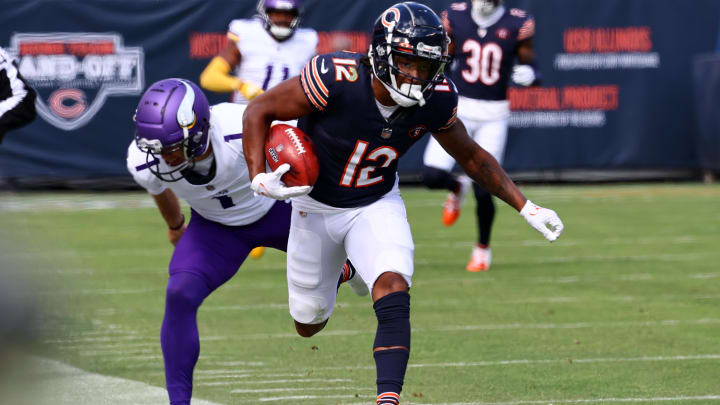Bears Join Other Teams Looking for an Edge on New Kickoff Rules

In the 1960s, Bears Hall of Famer Gale Sayers was too good as a return man to simply sit on kickoffs
The Bears also had Dick Gordon, though, and he had dangerous speed. So the Bears would put both back in two-deep formation to make sure kicks were returned by someone capable of taking it back.
Gordon had a 94-yard return and averaged 27.4 yards per 19 returns in 1966 while Sayers led the NFL with a 31.2-yard average and had two TDs.
Fast forward to today and it's entirely possible the Bears and other teams will be using the two-deep kick return formation again because the new kick return rules allow for two players back for kicks and no one else between the 30-yard line and goal line until the ball is touched after it's kicked.
Welcome to the new kickoff world of the NFL. Things will never be the same and the Bears are hoping to be on the cutting edge of this drastic change. They should be because Hightower was one of the three coaches who came up with the kickoff rule, borrowed heavily from the old XFL.
"So we're all on the same page on that and it's just going to be interesting because it's all new," Hightower said. "I mean, there are so many different forms of people that you can put out there.
"The imagination is going to take over. The creativity is going to take over, so it's going to be fun, and we're all excited about it."
I don't think people realize that Coach Hat is going to scheme up like 13 Return TDs for King Kene Nwangwu this SZN with the new kickoff rules. This will be cake. pic.twitter.com/VZFb6AQxx3
— Purple FTW! Podcast (@PurpleForTheWin) May 2, 2024
It seemed like they were excited during minicamp and OTAs when special teams work was going on because there was plenty of very loud talk. Louder always explains change better.
It's entirely possible the Bears didn't sign DeAndre Carter simply to have him compete with Velus Jones Jr. for the kick return job. He might be back returning the kicks with Jones.
Then again, who knows what their plans are for the return spots and even the blocking and coverage players.
They're not going to tell anyone at this point.
"So we've toyed around with a lot of different body types and techniques, and we're using still some of the same types of techniques, but it's just happening at a different point in the play," Hightower said.
#Browns special teams coordinator Bubba Ventrone on big-name players volunteering for kickoff return and coverage under the new rules: pic.twitter.com/2maOUanCVD
— Mary Kay Cabot (@MaryKayCabot) May 30, 2024
The reason for this is the kicks come from the 35 like before, but the coverage men are all lining up at the opponents' 40 and can't move until the ball is touched by a return man. And the blockers are all to line up between the 35 and 30, within 5 to 10 yards of the coverage men. The return men will have plenty of room to build up a head of steam if the kick is near the goal line as the blockers and coverage men do battle in a short space. If it's kicked shorter, then maybe they won't have so much time.
"So with the running start out, it's happening a lot quicker, like it's on you right now," Hightower said. "And that's what we're realizing and going through. So it's been fun as heck."
It might mean different types of players blocking on returns, and then different types of players in coverage. For instance, a team could go to a few big linemen on the blocking wall hoping to create a hole for the return men and the defense will want to counter with bigger players to handle those linemen.
"That's not what the rule is intended for, honestly," Hightower said. "But I'd be lying if I said I haven't heard that from some coaches. And that comes up, and more particularly for bigger defensive linemen that have the speed to do such."
#Bears Special Teams Coordinator Richard Hightower thinks Velus Jones should benefit from the NFL's new kickoff rule pic.twitter.com/V3NhgFisTu
— Barroom Network - Aldo Gandia (@BarroomNetwork) May 11, 2024
What was intended is a safe kickoff play with excitement. The XFL liked the way it worked.
Hightower might have been faking it a bit when asked if he knew what will happen eventually with personnel types needed for kickoff plays, because he was involved in bringing the rule change to life.
"I mean, I don't know to what extent because the league is all about matchups, especially when you're dealing with like special teams," Hightower said. "So like we're going to have to match up with whatever personnel group we're going against.
KHALIL HERBERT'S VALUE TOO HIGH TO BEARS FOR THOUGHTS OF A TRADE
DO BEARS RUNNING BACKS REALLY RANK IN THE NFL'S BOTTOM HALF?
BEARS WORK AT RECIEVER EARNS A NOD FOR OVERALL IMPROVEMENT
THE DARK SIDE TO ONE GLOWING PREDICTION ABOUT CALEB WILLIAMS
"And we've been fortunate to have bigger players that can run and also even smaller players who are more powerful like a Roschon (Johnson) or like a (Travis) Homer. Those guys can block linebackers and they're fast enough to block DBs. And then you've got your other body types like (Austin) Booker, who we just got just got, or we got Dom Robinson or Jake Martin we just signed. Those guys are bigger but they're fast enough too. So I think the personnel department has done a hell of a job getting a mix of all of those just to see what it looks like in the preseason."
Hightower said the rule could even mean some strange looking kickoffs from Cairo Santos, or even punter Tory Taylor kicking off at times because he's known as a magician for what his foot does with a ball.
Touchbacks come out to the 30 now, so that doesn't seem like a desired option. Or does it?
Depending on the opponent, Hightower said touchbacks might even be preferable to facing the new return.
Kickoff and kickoff return schemes have to be more creative with the new NFL rules. #TeaguesTake pic.twitter.com/iAgxq3kK7q
— George Teague (@Teaguefootball) April 6, 2024
"Like in our NFC North all the returners are loaded," Hightower said. "All the teams are loaded. If you don't have a returner in the NFC North you're behind the 8-ball. There's two All-Pros. There's an All-Pro up north in that team and then you've got the one at the Vikings too. So you've got to have one.
"So I think there will be times where there will be some touchbacks, but like more than anything we want to get more returns in the game. It's more opportunities for the coverage players."
The touchback does mean giving up field position.
"That means the drive start is going to increase," Hightower said. "So with the drive start increasing, we suspect scoring to increase. And what is that?
"That's a shorter field for Caleb (Williams) and the boys to go to work with. That's what it is. So it should be very exciting."
Nearly all of the questions that Seahawks ST coordinator Jay Harbaugh fielded during his 16-minute media session were about the new kickoff rules. He said there’s more unknown with how return units will respond than KO units. Of the latter, he said he expects more squib kicks. pic.twitter.com/kox8m5tzo9
— Brady Henderson (@BradyHenderson) June 3, 2024
Twitter: BearDigest@BearsOnMaven
